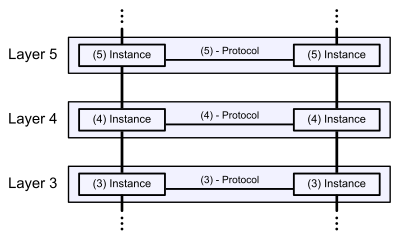OSI is a standard description or “reference model” for how messages should be transmitted between any two points in a telecommunication network. Its purpose is to guide product implementers so that their products will consistently work with other products. The reference model defines seven layers of functions that take place at each end of a communication. Although OSI is not always strictly adhered to in terms of keeping related functions together in a well-defined layer, many if not most products involved in telecommunication make an attempt to describe themselves in relation to the OSI model. It is also valuable as a single reference view of communication that furnishes everyone a common ground for education and discussion.
The Open Systems Interconnection model (OSI model) is a conceptual model from the International Organization for Standardization (ISO) that "provides a common basis for the coordination of standards development for the purpose of systems interconnection". In the OSI reference model, the communications between a computing system are split into seven different abstraction layers: Physical, Data Link, Network, Transport, Session, Presentation, and Application.
The model partitions the flow of data in a communication system into seven abstraction layers to describe networked communication from the physical implementation of transmitting bits across a communications medium to the highest-level representation of data of a distributed application. Each intermediate layer serves a class of functionality to the layer above it and is served by the layer below it. Classes of functionality are realized in all software development through all standardized communication protocols.
Each layer in the OSI model has well-defined functions, and the methods of each layer communicate and interact with those of the layers immediately above and below as appropriate.
The Internet protocol suite as defined in RFC 1122 and RFC 1123 is a model of networking developed contemporarily to the OSI model, and was funded primarily by the U.S. Department of Defense. It was the foundation for the development of the Internet. It assumed the presence of generic physical links and focussed primarily on the software layers of communication, with a similar but much less rigorous structure than the OSI model.
In comparison, several networking models have sought to create an intellectual framework for clarifying networking concepts and activities,[citation needed] but none have been as successful as the OSI reference model in becoming the standard model for discussing and teaching networking in the field of information technology. The model allows transparent communication through equivalent exchange of protocol data units (PDUs) between two parties, through what is known as peer-to-peer networking (also known as peer-to-peer communication). As a result, the OSI reference model has not only become an important piece among professionals and non-professionals alike, but also in all networking between one or many parties, due in large part to its commonly accepted user-friendly framework.



